It finally happened—our questions on Russia and Putin’s resoluteness have been answered. After a nearly two-month hiatus of major long-range strikes on energy infrastructure, Russia struck back again last night with what’s again being called one of the largest strikes of the war, which not only reportedly utilized a fleet of 16 Tu-95s, but according to some sources even a wing of Tu-160s for the first time.
Virtually every missile in Russia’s arsenal was said to be fired:
▪️Kh-101
▪️Caliber
▪️Kh-32/22
▪️Oniks
▪️Iskander
▪️Kinzhal
▪️Zircon (apparently 2 were fired on targets at Kiev)
Energy substations were hit all over the country. Kh-101s are here seen hitting Rivne city substations at geolocation 50.642217840275606, 26.224832322047448:


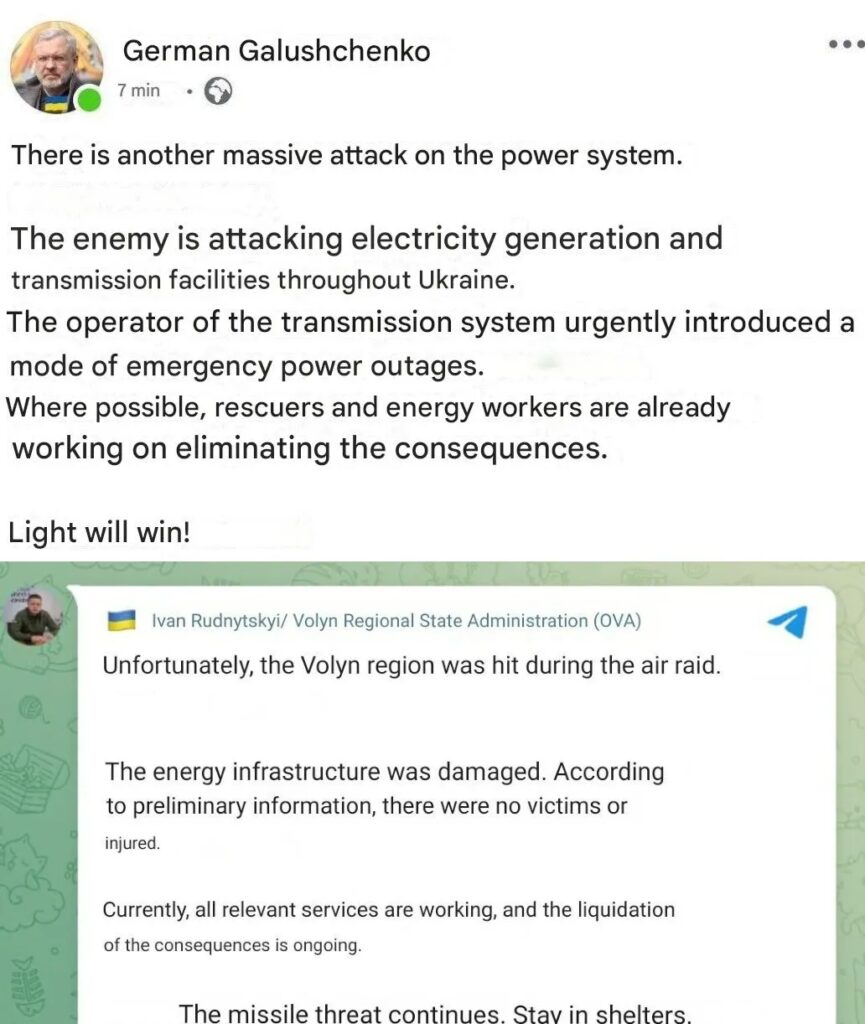
Bloomberg reports that generation at Ukrainian nuclear facilities was cut back by 40-90%, with only 2 out of 9 total reactors operating at full power:

An IAEA team based at the Khmelnytskyy Nuclear Power Plant reported hearing a loud explosion, while others stationed at the Rivne site reported that high-voltage power lines were unavailable. Both facilities are in western Ukraine.Keep in mind, Ukraine only has 3 nuclear plants remaining under its control, it’s just that each of those has multiple reactors, thus the 9 total counted. As you can see, Rivne with 4, Khmelnytskiy with 2, and Yuzhnoukrainsk with 3 reactors:
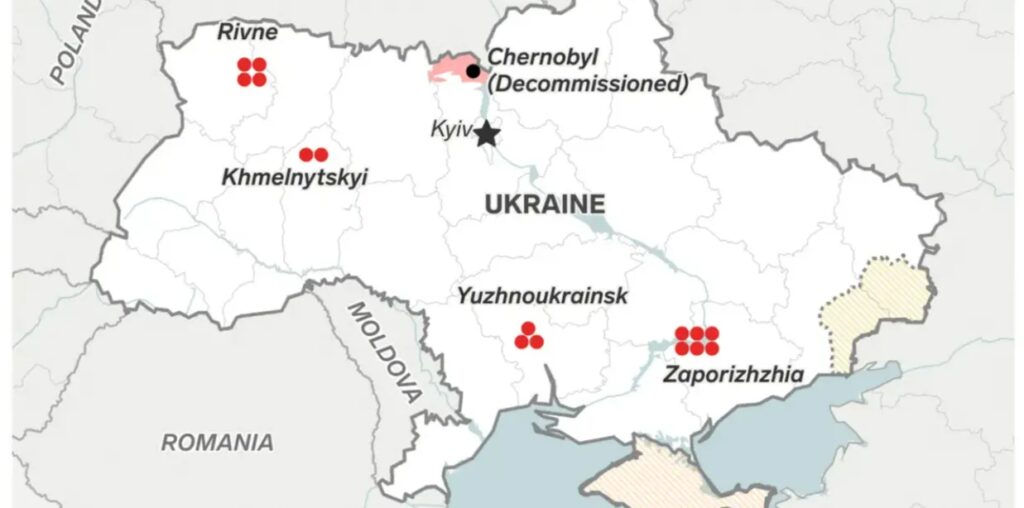
It was said that the major energy terminal in Mukachevo, far western Ukraine, was hit, which couples and transmits European energy to Ukraine. Needless to say, if the hit was effective, it could in large part cut Ukraine off from emergency power transmission from Europe:

Ukrainian intelligence claims that Russia has stockpiled enough missiles for several of such large strikes in a row.

Protocol would have it that more systematic strikes like this would follow, weekly or so, for the winter campaign. Russian ISR would spend some time doing damage assessments then continue levying strikes on the areas which need further degrading.
Now, as if timed to stave off the morale depletion of the coming ‘dark winter’, Biden is reportedly set to announce the removal of long-range strikes restrictions on Ukraine’s ATACMS:

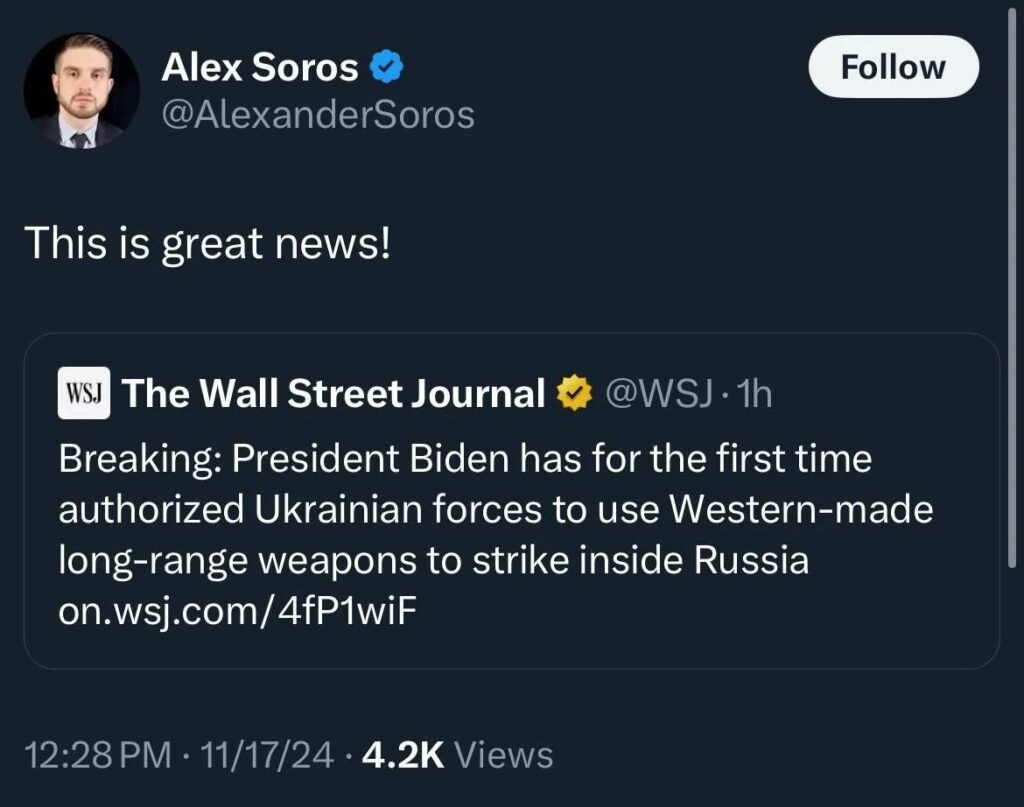
This announcement was reportedly immediately followed by France and Britain authorizing use of Storm Shadow/Scalp missiles on Russian territory as well. As we’ve discussed here many times, politically neutered and ideologically paralyzed Europe can do nothing without its master first giving the go ahead or signaling support.

However, take everything with a pinch of salt for now as there are already predictable conflicts, and the whole thing has taken on a familiar back and forth:



The wording in the message, such as “close to adoption,” “if approved,” and “if received,” emphasizes the uncertainty of the situation, without confirming direct permission from the US president.In the NYT article above, they seem to imply the strikes could be limited to just a narrow band of Kursk, where the purported “North Korean troops” may be active.
The weapons are likely to be initially employed against Russian and North Korean troops in defense of Ukrainian forces in the Kursk region of western Russia, the officials said.There’s a lot of things to say about this development.
Firstly: ATACMS have already disappeared from the battlefield, the last usage being recorded something like months ago.
Second: HIMARS have already been used all over Kursk, including on a Russian column some months ago. Both regular HIMARS missiles and ATACMS are fired from the same truck—so this new ‘authorization’ strikes as a little strange. Though the NYT article addresses this:
To help the Ukrainians defend Kharkiv, Mr. Biden allowed them to use the High Mobility Artillery Rocket System, or HIMARS, which have a range of about 50 miles, against Russian forces directly across the border. But Mr. Biden did not allow the Ukrainians to use longer-range ATACMS, which have a range of about 190 miles, in defense of Kharkiv.The difference is that Ukraine can target HIMARS with their own tactical-depth drone interfaces, whereas to launch ATACMS at an operational-strategic depth would require higher level involvement, and potentially NATO satellite ISR, etc. However, that only makes a difference if ATACMS is actually allowed to be fired into the operational depth, whereas certain “hints” continue to indicate it may be a more limited geographical window—which would make this ‘authorization’ no different than previous HIMARS use.
Third: HIMARS, M270s and German Mars II variants have all been greatly attrited during the Kursk excursion of the past three months to the point that it’s questionable how many units Ukraine even has remaining. It may be a few but not enough to conduct big simultaneous volleys of ATACMS, which—unlike regular HIMARS missiles—can only be fired one at a time per truck.
The announcement comes just as ATACMS stocks have been depleted, with several articles over the past month or so noting this. The same goes for Storm Shadow/Scalp:

From The Sunday Times:
Defence sources have suggested that Labour’s reluctance to do so is likely to stem from the fact that UK stockpiles have reached a level below which military chiefs are not prepared to go, because a certain number must be kept in reserve to protect the UK’s own interests.It begs the question, is this more smoke and mirrors meant to bolster Ukrainian morale without actually angering Russia too much?
The natural interpretation, of course, is that Biden seeks to wreck Trump’s chances of ending the war by a last minute escalation and provocation in one which could put Russia on a vengeful track that would dash any post-inauguration peace talks. It really all depends on what the secret fine print and limitations on the strikes will be—for instance, as stated, only in the narrow circle around the Kursk fighting, rather than attacks to the true operational or strategic depth.

But the NYT article reveals the other real reason for the desperate escalatory behavior:
The Ukrainians hope that they would be able to trade any Russian territory they hold in Kursk for Ukrainian territory held by Russia in any future negotiations.
If the Russian assault on Ukrainian forces in Kursk succeeds, Kyiv could end up having little to no Russian territory to offer Moscow in a trade.
Officials said Mr. Biden was persuaded to make the change in part by the sheer audacity of Russia’s decision to throw North Korean troops at Ukrainian lines.
He was also swayed, they said, by concerns that the Russian assault force would be able to overwhelm Ukrainian troops in Kursk if they were not allowed to defend themselves with long-range weapons.So, Biden was “swayed” by the possibility that Russia could kick Ukraine out of Kursk. Remember when the US pretended to not be on board with the Kursk operation at all? Now suddenly they too realize it’s Ukraine’s only remaining chance at some semblance of a negotiating position.
And that’s really all that matters, as they openly admit the ATACMS won’t actually do anything to change the war itself:

Interview from September is a reminder of what Putin had to say about the long-range strike escalation:
He confirms what I said earlier: that Ukraine is already capable of doing moderate tactical level ISR over Russia’s borders with its own small drones; but long-range strikes deep into Russian territory is a whole other story. Putin ends up saying appropriate decisions will be made if Russia deems the US and NATO as being officially at war with Russia, which will be the case if this long-range strike decision actually stands.
Many people believe that Russia would not asymmetrically respond by, for instance, arming the Houthis because Russia has shown official support to the Aden government at the UN level.
But the situation is not so clear cut. Western intel agencies report Russia has already been supplying targeting data to Houthis, though of course this could be psyop information:

One interesting clip that has gone viral this week amongst the networks featured undersecretary of defense William Laplante admitting he was blown away by the Houthi’s sudden and miraculous advancement of missile technology, which seemingly came out of no where—where do you think it might have come from so out of the blue?
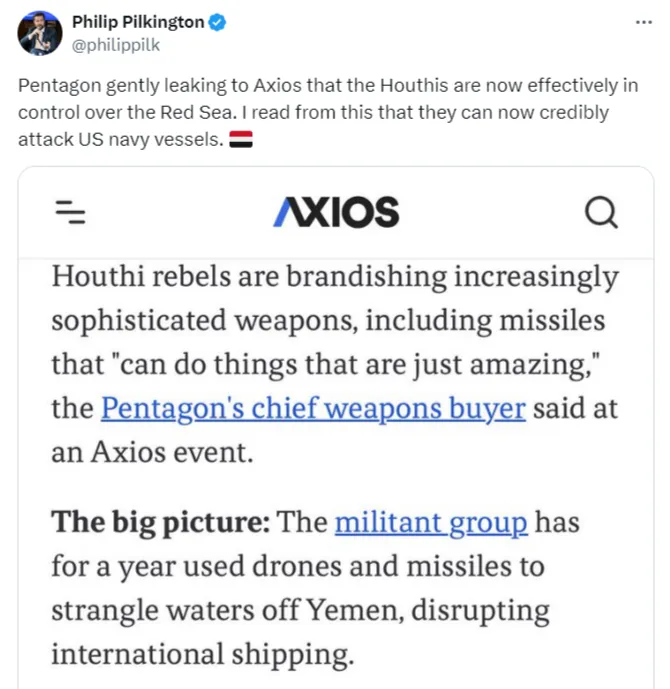
The other most interesting update:
Recall a couple reports ago I had put forth a theory from another analyst that Trump could cleverly stage an attempt to end the war, but then blame Zelensky for being hard-headed and “wash his hands” of it all, dumping the conflict on Europe.
Now for the first time, a major MSM outlet has lent credence to this. The latest FT article outright states that Trump may blame his failures on Zelensky’s intransigence and walk away:

This would solve the great conundrum of: how does Trump prevent a total Ukrainian loss becoming his ‘Afghanistan withdrawal’ fiasco? By dumping all blame on an unmovable Zelensky, Trump could say ‘he tried’—perhaps then levying the remainder of the blame on Biden’s administration.
The last selection is interesting for the overlapping new theme it represents. Two articles, from Politico and New York Times, both unexpectedly propose that Trump’s election win is probably actually a good thing for Ukraine.
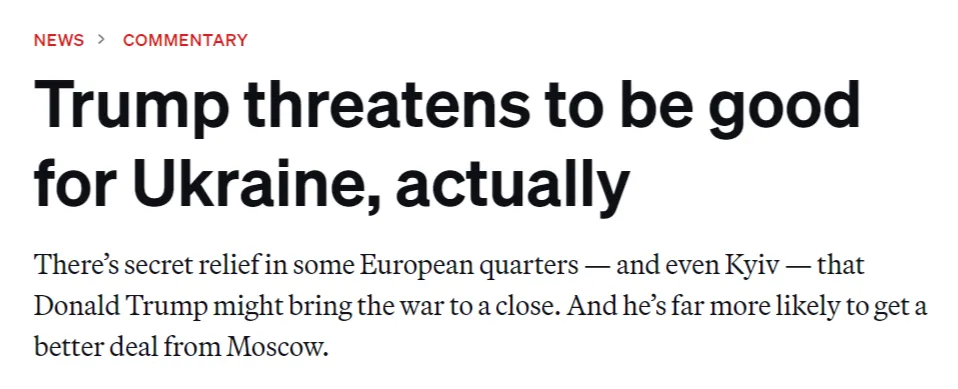

The NYT piece is remarkable in its admissions. It says that Trump forcing Ukraine to give up land would look like a major defeat of the West, but no matter—the author writes it is necessary because Ukraine is being devastated and Putin has no reason to stop; finally reality dawns on them!
Despite flashes of spectacular success by Ukrainian forces, the Russian position has gradually strengthened, and there is no reason to expect Mr. Putin to lose the upper hand now. That may sound like defeatism, but it’s also realism. The even bigger admission is the now naked truth that the war is in fact a proxy war, spurred on by NATO and the West:
I believe it’s right to call Ukraine a proxy war, because I think it’s reasonable to conclude that the Biden administration has supported the war not only in deference to righteous Ukrainian determination to fight off Russia but also because the war was a chance to debilitate our enemy without directly engaging it.For the first time, MSM makes headway in acknowledging the West’s participation in the Ukraine’s exploitation, even if only by a halfway measure:
Now another cold winter bears down, and Ukraine’s electricity infrastructure is so bomb-wrecked that people are expected to endure daily blackouts of up to 20 hours through the dark and bitter months.
This bleak landscape contains the most extreme and tragic results of the power games that have been played out mercilessly on Ukrainian soil by greater powers. Both Russia and the United States have for decades exploited Ukraine’s internal divisions to undermine each other and jockey for regional influence, usually at the expense of ordinary Ukrainians.
The author even goes on to admit the Bush administration heavily backed the Orange Revolution of 2004, “shower[ing] the pro-Western groups with funding and training.”
The final flourish says it all:
It is this uneasy dynamic — a Ukraine close to the West, striving for inclusion in the West, but not truly part of it — that has defined the U.S. management of this disastrous war. We want Ukraine to function as a protectorate, but ultimately, we are unwilling to protect it. A sensible, ugly strategy — tactically defensible but morally reprehensible.
America is not going to save Ukraine. Maybe we need Mr. Trump — brazen and unscrupulous — to finally say so out loud and act accordingly.The Politico article strikes the same note, essentially arguing that Trump will be doing the West a huge favor by saving them from their own self-wrought unwinnable catastrophe. According to them, Kiev secretly knows that Trump is a better option than Harris because Trump is more likely to get a deal ‘favorable to Ukraine’ from Putin, whereas Harris and co. would have just prolonged the slaughter indefinitely, keeping to this waffling noncommittal track.
According to the author, everyone will get a ready excuse:
After all, if he’s successful, European leaders and American hawks will have an alibi, and Ukrainian President Volodymyr Zelenskyy will have cover from likely angry front-line Ukrainian soldiers. They’ll all blame him for the broken promises, for the loss of the Donbas and Crimea’s continued annexation — because that’s what it will take to ink a deal. That, and an agreement that Ukraine won’t be joining NATO — neutrality will be a firm concession Moscow will demand.
“At best, Harris would have maintained Joe Biden’s approach — that would have been her policy, and it would have amounted to Ukraine’s slow death. And not so slow anymore — the pace of the Russian gains is quickening,” he noted.Isn’t cold, hard reality a beautiful thing?
But the article adds one final caveat, that Trump is unlikely to simply leave Ukraine out in the cold:
Mike Pompeo, secretary of State in Trump’s first administration, is of the same opinion: “President Trump is not going to allow Vladimir Putin to roll through Ukraine,” he said Monday. “Withdrawing funding from the Ukrainians would result in that, and he will be told that by his entire team. It’s not his M.O. to allow that to happen.”It gets back to what we talked about last time: Trump loves to have his cake and eat it too. He would love to profit from both sides of the equation by satisfying Ukraine with arms so he doesn’t “look like a big loser” or betrayer, while at the same time, courting Russia for concessions and an armistice. But such “two-chair” tactics won’t work for now-hardline and maximalist Russia, and so the only question which remains is will Trump be angered once his ego is hurt by Putin’s snub, and thus try to ‘strongman’ himself into some escalation to upstage Russia? Or will he smartly cede the floor to Russia’s advantages and realize WWIII is not worth it for his grand capitalist revival dreams?

Last thoughts on the above:
Trump takes office in two months and could presumably instantly roll-back Biden’s ‘deep strikes’ authorization, completely negating any effect by limiting their use to a tiny irrelevant time window.
The other thing is that Europe continues to crumble, with Macron having no favor at home, and Germany’s government now lacking a majority, with Scholz on the way out. Ukraine’s future vis-a-vis the mythical ‘European solidarity’ is on quite shaky grounds. Couple this with Russia’s now-resumed ‘Dark Winter’ campaign, and the next few months could be extremely rocky for Ukraine, particularly given the fact that Russia’s advances and territorial captures continue accelerating.
The new strikes authorization is presumably meant to tide Ukrainian societal morale over for a few months, with perhaps some kind of flashy ‘hit’ somewhere, that will be oversold as “devastating” to Russia, but it’s questionable how much mileage they can get even out of that anymore.
Remember: for the Storm Shadows to be fired “deep” into Russian territory, the F-16s—or whatever platform carrying them—would have to get almost right up to the Russian border, and risk almost certain shoot down by Russian patrol craft, long range AD, etc. The same goes for ATACMS—everyone just assumes it can hit max distance into Voronezh, but to do that the ATACMS would have to be right on the border. They learned the hard way what happens when they try that, as a slew of HIMARS trucks were destroyed not far from the border in the Kursk fiasco.
With stockpiles for both ATACMS, Storm Shadows, and even future-potential Taurus missiles scraping the bottom of the barrel, it’s not expected they could make any real mark.
As for Crimea Bridge, since someone mentioned it: I’m now of the mind that Kiev already missed its window and likely can no longer even attempt hitting the bridge. That’s because they have too few stocks and assets to do real damage, as the bridge would require dozens of simultaneous missiles to hit, let alone be launched—since many of them would be shot down. And for Ukraine, the bridge represents a kind of mystical Camelot on the hill or holy grail. As such, it has more magical power as a “potential” target and object of leverage and threat against Russia. If they were to try a big hit and fail, it would represent the total dissipation of their one and only remaining trump card. For them such a failure would be dangerous, leaving them exposed; as such, I don’t expect them to risk losing their only illusory ‘Damocles sword’—so the bridge strikes will likely remain a threatening phantom kept in the back pocket, never to actually materialize.
German TV with a dismal report from Ukraine:
German state TV complains from Kiev:
- The Russians advance every day in many places
- Ukrainian soldiers run away
- Ukrainian soldiers commit suicide
The situation is really bad at the front. Eurasia Press & News
Eurasia Press & News




